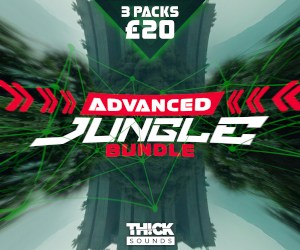Latest releases
Recent Releases
-
-
 ►i
►i
Indo House
by: Loopmasters
-
 ►i
►i
Epicus - Film Foley & Sound FX
by: Loopmasters
-
 ►i
►i
Heart Felt Piano
by: Organic Loops
-
 ►i
►i
Relic Techno
by: RV Samplepacks
-
 ►i
►i
Mainground Techno Vol. 9 by NoNameLeft
by: Mainground Music
-
 ►i
►i
HAWK Tech House
by: Singomakers
-
 ►i
►i
Nu Disco Vocal Anthems
-
 ►i
►i
CALYPSO: Jungle
by: Ghost Syndicate
-
 ►i
►i
Botanica
by: Famous Audio
-
 ►i
►i
Drum & Bass Illusion
by: House Of Loop
-
 ►i
►i
CYCLONED: Phase Plant Presets
by: DABRO Music
-
 ►i
►i
Synapse
by: Form Audioworks
-
 ►i
►i
Hollywood Hits: Aftershock
by: Cinetools
-
 ►i
►i
Arabic Afro House 3
by: HY2ROGEN
-
 ►i
►i
Iridescent: Deep House
by: Rewind Samples
-
-
-
 ►i
►i
Ambient Downtempo Dub Vol. 1
by: Renegade Audio
-
 ►i
►i
Conceptual Techno
by: BFractal Music
-
 ►i
►i
Mechanism - Dark Techno
by: Blind Audio
-
 ►i
►i
Launch Pad Series Vol 35 - Riddim Revival
by: Renegade Audio
-
 ►i
►i
Serene Progressive House
by: THICK Sounds
-
 ►i
►i
Ultimate Percussion Collection Vol 3
by: Renegade Audio
-
 ►i
►i
Rawtekk DnB Work 3
by: Noise Design
-
 ►i
►i
Space Motion Melodic Techno
by: Dropgun Samples
-
 ►i
►i
Big Beat Guitars
by: Image Sounds
-
 ►i
►i
Vocal Tech House Vol.1
by: Rasster Samples
-
 ►i
►i
Big Room Tech House
by: Black Octopus
-
 ►i
►i
UK Bass Ultra Pack
by: 91Vocals
-
 ►i
►i
Deep In
by: Producer Loops
-
 ►i
►i
Vandal
by: Zenhiser
-
 ►i
►i
AZS Tranceform for Arturia JUP-8000
by: Resonance Sound
-
-
-
 ►i
►i
Music4Aliens - Minimal and Techno V3 by Gizmo & Mac
by: Resonance Sound
-
 ►i
►i
Soniqe Sound - Textural Beats
by: Resonance Sound
-
 HOT
►i
HOT
►i
Alex Tarnovski - UKG & Bassline
by: Loopmasters
-
 ►i
►i
Evocative Deep Tech & Progressive
by: Loopmasters
-
 ►i
►i
Power Techno
by: Samplestate
-
 ►i
►i
Cymbalism
by: Loopmasters
-
 HOT
►i
HOT
►i
Deeperfect Artist Series - CYAVA
by: Deeperfect
-
 ►i
►i
Codex Samples Vol. 9 - Hard Techno by Andy Mart
by: Codex Samples
-
 ►i
►i
HYPNOTICA - Hypnotic Techno
by: Keep It Sample
-
 ►i
►i
Aesthetic Deep Progressive House
by: Apollo Sound
-
 ►i
►i
Gradient - Minimal & Tech
by: Blind Audio
-
 AWARD
►i
AWARD
►i
Tech House Vocal Anthems 2
by: HY2ROGEN
-
 ►i
►i
Fraxil: Hard Techno
by: Rewind Samples
-
 AWARD
►i
AWARD
►i
Serum 2 Tech House Presets
by: Singomakers
-
 ►i
►i
Dub Pack Series Vol 18 - Rockers Delight
by: Renegade Audio
-
-
-
 ►i
►i
Industrial Techno Essentials
by: Element One
-
 ►i
►i
Augmentix: Hybrid Cyberpunk Scoring
by: Leitmotif
-
 ►i
►i
Explosive Hard Techno
by: THICK Sounds
-
 ►i
►i
Neuro DNB Bundle
by: Blind Audio
-
 ►i
►i
Hip Hop Action Score
by: BFractal Music
-
 ►i
►i
VELORA: Tropical Pop Melodics
by: DABRO Music
-
 ►i
►i
Re-Defined: Afrobeat Breaks
by: Rewind Samples
-
 ►i
►i
Freaky Loops - Hyper Beats
by: Freaky Loops
-
 ►i
►i
Character Motion
by: SFXtools
-
 ►i
►i
Industrial Breaks
-
 ►i
►i
Launch Pad Series Vol 34 - Jungle Circuit
by: Renegade Audio
-
 ►i
►i
Equinox - Psytrance
by: Zenhiser
-
 ►i
►i
Memphis Hip-Hop
by: Function Loops
-
 ►i
►i
Viral Trap
by: Function Loops
-
 ►i
►i
Nu Skool Garage & House Vol 2
by: Samplestar
-

-
 Studio
Studio
Artist Series: Best of Deep House
-
 Studio
Studio
Artist Series: Best of Techno
-
 Studio
Studio
Artist Series: Best of Drum and Bass
-
 Studio
Studio
Artist Series: Best of Hip Hop
-
 Studio
Studio
Artist Series: Best of Tech House
-
 DAW Tutorials
DAW Tutorials
How to create your own vocal chops
-
 Studio
Studio
How to get Samples in Key with your Track
-
 Plugins
Plugins
The Best Timestretch and Pitchshifting Software & Plugins
News and Reviews
-
 news
news
Loopmasters Holiday Advent Calendar - A New Gift Every Few Days
-
 news
news
Black Friday Deal: Get a Free Sample Pack with Every Purchase at Loopmasters!
-
 review
review
Unity Records – Unity Samples Vol.31 by Tony Romanello Future Music Review
-
 review
review
Bingoshakerz - Organic Jazzy Downtempo 2 - Computer Music Magazine Review
VIP Reviews
available_prices
Loopmasters is the definitive place to find the best sample libraries for your music. With the latest sounds from established producers, industry heavyweights and upcoming beatmakers, provided as royalty free samples and loops. Every one of our sample packs is crammed with the best music samples, meticulously produced, prepared and formatted for smooth integration in your workflow.
We’ve got the best sample packs for House, Techno, Drum & Bass, EDM and loads more, with live music sample packs and instrument sample libraries to embellish and develop your unique sound. Our royalty free music samples come from artists, producers and instrumentalists across the globe, ensuring you get the best loops played and recorded at the highest quality by seasoned professionals and top studio engineers.
Download royalty free sounds from our website or using Loopcloud, the online cloud-based browser where you’ll find exclusive content each week free to add to your music sample library. Browse our entire catalogue and discover more royalty free music loops - download samples you like using our intuitive software, which integrates seamlessly with the major daws.
Our royalty free music samples come organised and labeled so you can be sure of staying in key and getting the tempo right, and in the most popular formats, with rex loops, acidized wavs and apple loops to suit your preference.
































